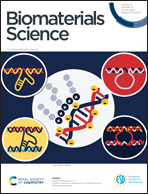The effects of silk layer-by-layer surface modification on the mechanical and structural retention of extracellular matrix scaffolds†
Abstract
Naturally derived extracellular matrix scaffolds can effectively promote tissue repair and regeneration due to their remarkable bioactivity. However, their rapid degradation leads to the decrease of mechanical retention and the failure of physical support in vivo which limit their applications. In this paper, we modified a classic extracellular matrix scaffold – small intestinal submucosa (SIS) – by a silk fibroin (SF) layer-by-layer (LbL) assembly to replace the existing chemical crosslinking methods for improving its mechanical and structural stability. Experimental results showed that the SF LbL surface functionalized SIS scaffold had tunable mechanical properties and degradation rate by adjusting the number of layers of the SF deposited on the surface. For biological responses, in vitro NIH3T3 fibroblast culture studies demonstrated that SF surface modification did not affect the excellent biocompatibility of the SIS. In vivo subcutaneous implantation results showed that the SF modification could effectively extend the residence time of the SIS in the body, and elicit a more moderate inflammatory response compared to the traditional glutaraldehyde chemical crosslinking. Furthermore, we found that SF modification could maintain the ability of bioactive components of the SIS to regulate the transformation of M1 into M2 in macrophages in vivo. This SF LbL modification strategy offers a green process for the development of high-performance extracellular matrix-based scaffolds with tunable biodegradability.



 Please wait while we load your content...
Please wait while we load your content...